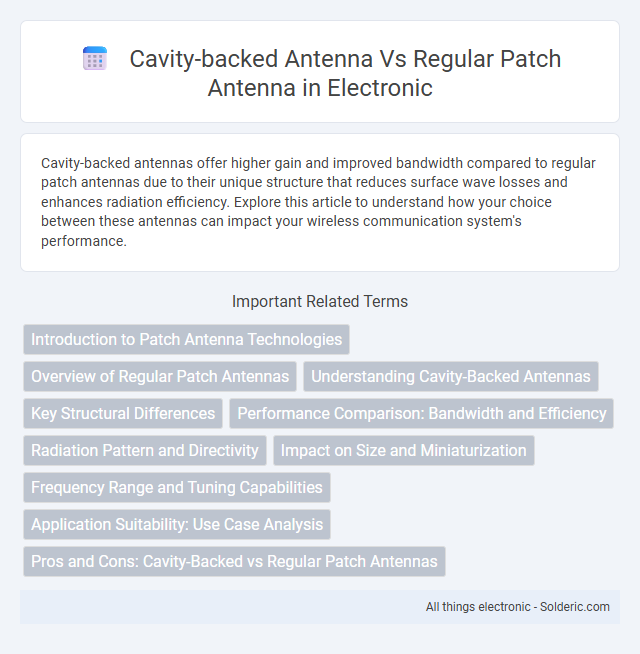Cavity-backed antennas offer higher gain and improved bandwidth compared to regular patch antennas due to their unique structure that reduces surface wave losses and enhances radiation efficiency. Explore this article to understand how your choice between these antennas can impact your wireless communication system's performance.
Comparison Table
| Feature | Cavity-Backed Antenna | Regular Patch Antenna |
|---|---|---|
| Structure | Patch mounted over a metallic cavity | Patch mounted on a dielectric substrate |
| Bandwidth | Wide bandwidth, typically several GHz | Narrow bandwidth, usually a few % of center frequency |
| Gain | High gain due to cavity resonance | Moderate gain, typically 6-9 dBi |
| Size | Larger due to cavity structure | Compact, low-profile design |
| Efficiency | High efficiency with reduced surface wave losses | Moderate efficiency, affected by substrate losses |
| Applications | Radar, satellite communication, wideband systems | Wireless communication, GPS, mobile devices |
| Cost and Complexity | Higher manufacturing complexity and cost | Simple fabrication, cost-effective |
Introduction to Patch Antenna Technologies
Patch antennas, popular for their low profile and ease of fabrication, come in various designs including regular and cavity-backed types. Regular patch antennas utilize a flat metallic patch on a dielectric substrate to radiate, whereas cavity-backed antennas incorporate a metallic cavity beneath the patch to enhance bandwidth and reduce surface wave losses. You can achieve improved performance in applications requiring higher gain and wider bandwidth by choosing a cavity-backed antenna over the conventional patch design.
Overview of Regular Patch Antennas
Regular patch antennas consist of a flat rectangular or circular metal patch mounted on a grounded dielectric substrate, widely used for their low-profile and ease of fabrication. They exhibit moderate bandwidth and gain, making them ideal for applications like GPS, Wi-Fi, and mobile communications. Your choice of a regular patch antenna suits environments where compact size and planar design are essential, though it may face limitations in bandwidth compared to cavity-backed designs.
Understanding Cavity-Backed Antennas
A cavity-backed antenna features a resonant cavity behind the radiating patch, enhancing its gain, bandwidth, and radiation efficiency compared to a regular patch antenna. This design reduces surface wave losses and improves directivity, making it ideal for applications requiring precise beam control and lower interference. Understanding the structural differences in your antenna choice can significantly impact the overall system performance in wireless communication.
Key Structural Differences
Cavity-backed antennas feature a resonant cavity beneath the radiating patch, providing enhanced shielding and improved radiation efficiency compared to regular patch antennas, which lack this cavity. The metal cavity in cavity-backed designs acts as a ground plane, reducing surface waves and enhancing bandwidth, whereas regular patch antennas rely solely on a dielectric substrate. Consequently, cavity-backed antennas typically offer better isolation and reduced back radiation, making them ideal for applications requiring high gain and directional control.
Performance Comparison: Bandwidth and Efficiency
Cavity-backed antennas typically offer wider bandwidth and higher efficiency compared to regular patch antennas due to their ability to minimize surface wave losses and improve impedance matching. The metal cavity acts as a ground plane, effectively enhancing radiation efficiency and reducing substrate-related energy dissipation. Regular patch antennas, while compact and low-profile, often suffer from narrow bandwidth and lower radiation efficiency caused by substrate losses and surface wave excitations.
Radiation Pattern and Directivity
Cavity-backed antennas exhibit a more focused radiation pattern with higher directivity compared to regular patch antennas, which typically have broader and less directional radiation characteristics. The cavity backing confines the electromagnetic energy, enhancing gain and reducing back radiation, making cavity-backed antennas ideal for applications requiring precise signal targeting. Your choice of antenna should consider these differences to optimize performance in communication or radar systems.
Impact on Size and Miniaturization
Cavity-backed antennas significantly reduce surface wave losses, enabling more efficient radiation and sharper beam control compared to regular patch antennas. This efficiency allows cavity-backed designs to achieve smaller footprint sizes without compromising performance, making them ideal for miniaturized applications. In contrast, regular patch antennas often require larger substrate areas to maintain gain and bandwidth, limiting their effectiveness in compact device integration.
Frequency Range and Tuning Capabilities
Cavity-backed antennas offer a wider frequency range and improved tuning capabilities compared to regular patch antennas due to their enclosed ground cavity, which reduces surface wave losses and enhances bandwidth. Regular patch antennas typically have narrower bandwidth and limited frequency tuning flexibility because of their open structure and reliance on substrate properties. Your choice between these antennas should consider the required frequency agility and the need for precise tuning in your application.
Application Suitability: Use Case Analysis
Cavity-backed antennas offer enhanced bandwidth and improved radiation efficiency, making them ideal for high-frequency applications such as radar and satellite communication where performance under harsh conditions is critical. Regular patch antennas are commonly used in consumer electronics and wireless communication due to their low profile, ease of fabrication, and cost-effectiveness, suitable for applications with moderate performance requirements. Your choice should consider specific use case demands, including environmental conditions, frequency range, and required antenna gain.
Pros and Cons: Cavity-Backed vs Regular Patch Antennas
Cavity-backed antennas offer superior bandwidth, higher gain, and better power handling compared to regular patch antennas, making them ideal for high-performance applications. Regular patch antennas are typically more compact, lightweight, and cost-effective but suffer from narrower bandwidth and lower efficiency. Your choice depends on the need for enhanced performance with cavity-backed designs or the simplicity and affordability of standard patch antennas.
cavity-backed antenna vs regular patch antenna Infographic

 solderic.com
solderic.com